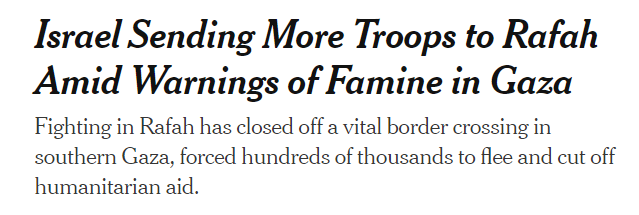“Famine is imminent as 1.1 million people, half of Gaza, experience catastrophic food insecurity,” the Integrated Food Security Phase Classification (IPC) claimed in a special brief published on March 18.
Following its release, major news organizations jumped at the opportunity to include the word “famine” in their headlines.



However, a new report released on June 4 by the IPC’s Famine Review Committee (FRC) uncovered several flaws in the original data published in March, leading them to amend their original claims. Ultimately, the FRC concluded that they cannot consider the situation in Gaza a “famine.”
Here are the most significant points that deserve to be highlighted:
- The original report said that the caloric availability in the area covered only “59-63% of the needs (based uniquely on Humanitarian Food Assistance) in April.”
- The new report estimates the range of coverage of caloric availability was actually 75-109%.
So how did the IPC go from claiming that Gazans in the north were nowhere near getting their nutritional requirements to acknowledging that they were nowhere near being underfed? How did they get it so wrong the first time?
- When discussing food trucks and other methods of aid entering the area, the IPC excluded commercial and/or privately contracted deliveries and World Food Program (WFP) deliveries to bakeries in northern Gaza from their original numbers.
- The original report “relied on multiple layers of assumptions and inference, beginning with food availability and access in northern Gaza and continuing through nutritional status and mortality.”
- There may have been a “mismatch in reporting periods” by the Famine Early Warning Systems Network (FEWS NET).
While the corrected data from the FRC is receiving publicity on various X (formerly Twitter) threads, major news organizations seem to be ignoring its release.
¹ Remember the famous IPC report claiming that Gaza – especially the northern part – is “facing imminent famine”?
Well, turns out that on June 4, the Famine Review Committee (FRC) published a new analysis that, as far as I could see, received ZERO coverage in the media -…
— Mark Zlochin – מארק זלוצ’ין༝ (@MarkZlochin) June 16, 2024
The media is engaging in a concerted effort to promote the “famine in North Gaza” lie — and the data shows it clearly.
Since about November, we’ve been hearing that “famine is imminent” in Gaza. Those claims have received considerable attention by the media.
But earlier… pic.twitter.com/wz2XaMrgOF
— Eitan Fischberger (@EFischberger) June 16, 2024
By failing to report on the most recent information, news organizations are misleading their audience about the extent of food flowing into Gaza and misrepresenting the hunger situation in the area.
Even more dangerously, on June 16, almost two weeks after the new data was released, The New York Times still referenced the outdated, invalidated claims.

Why hasn’t The New York Times consulted the new data and instead continues to link false information in its articles?
The new report from the FRC states that it is impossible to determine the number of people who are completely unable to access food in Gaza, and it is inaccurate to continue to say that Gaza is under threat of “imminent famine.”
This is not to suggest that there are not serious problems distributing food in a war zone. But 32 deaths attributed to malnutrition do not exceed the threshold necessary to be considered a “famine,” and most of those suffered from pre-existing conditions.
Instead, the updated data has barely elicited a ripple from the mainstream media, with only Fox News giving the story the attention it deserves. Like many others, The New York Times’ choice to ignore new data contributes to a media environment that villainizes Israel, and contributes to the accusations in places such as the International Court of Justice that Israel is deliberately starving Palestinians.
Instead of misleading their audiences by endorsing false claims that there is an insufficient amount of food entering the area, news outlets should better focus their reporting on the collective responsibility of multiple parties in making sure the food is distributed to civilians in need.
One can only hope that as new data emerges, reporting from major news organizations will uphold their journalistic integrity and update their audiences following suit.
Liked this article? Follow HonestReporting on Twitter, Facebook, Instagram and TikTok to see even more posts and videos debunking news bias and smears, as well as other content explaining what’s really going on in Israel and the region. Get updates direct to your phone. Join our WhatsApp and Telegram channels!
Image Credit: Majdi Fathi via TPS

